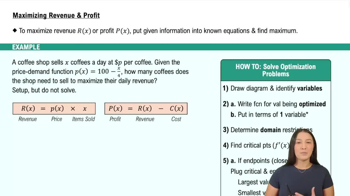Table of contents
- 0. Functions7h 52m
- Introduction to Functions16m
- Piecewise Functions10m
- Properties of Functions9m
- Common Functions1h 8m
- Transformations5m
- Combining Functions27m
- Exponent rules32m
- Exponential Functions28m
- Logarithmic Functions24m
- Properties of Logarithms34m
- Exponential & Logarithmic Equations35m
- Introduction to Trigonometric Functions38m
- Graphs of Trigonometric Functions44m
- Trigonometric Identities47m
- Inverse Trigonometric Functions48m
- 1. Limits and Continuity2h 2m
- 2. Intro to Derivatives1h 33m
- 3. Techniques of Differentiation3h 18m
- 4. Applications of Derivatives2h 38m
- 5. Graphical Applications of Derivatives6h 2m
- 6. Derivatives of Inverse, Exponential, & Logarithmic Functions2h 37m
- 7. Antiderivatives & Indefinite Integrals1h 26m
- 8. Definite Integrals4h 44m
- 9. Graphical Applications of Integrals2h 27m
- 10. Physics Applications of Integrals 2h 22m
5. Graphical Applications of Derivatives
Applied Optimization
Problem 46
Textbook Question
Suppose you own a tour bus and you book groups of 20 to 70 people for a day tour. The cost per person is $30 minus $0.25 for every ticket sold. If gas and other miscellaneous costs are $200, how many tickets should you sell to maximize your profit? Treat the number of tickets as a nonnegative real number.
 Verified step by step guidance
Verified step by step guidance1
Define the variables: Let x be the number of tickets sold. The cost per person is given by the expression $30 - 0.25x$.
Write the revenue function: The revenue R(x) is the product of the number of tickets sold and the cost per person, so R(x) = x * (30 - 0.25x).
Write the cost function: The total cost C(x) is the sum of the fixed costs, which is $200, so C(x) = 200.
Write the profit function: The profit P(x) is the revenue minus the cost, so P(x) = R(x) - C(x) = x * (30 - 0.25x) - 200.
Find the maximum profit: To maximize the profit, take the derivative of P(x) with respect to x, set it equal to zero, and solve for x. This will give the number of tickets that should be sold to maximize profit.
 Verified video answer for a similar problem:
Verified video answer for a similar problem:This video solution was recommended by our tutors as helpful for the problem above
Video duration:
5mPlay a video:
Was this helpful?
Key Concepts
Here are the essential concepts you must grasp in order to answer the question correctly.
Profit Function
The profit function represents the difference between total revenue and total costs. In this scenario, the revenue is derived from ticket sales, calculated as the number of tickets sold multiplied by the price per ticket. The costs include fixed expenses, such as gas and miscellaneous costs. Understanding how to formulate and analyze this function is crucial for determining the optimal number of tickets to sell.
Recommended video:

Example 3: Maximizing Profit
Revenue Maximization
Revenue maximization involves finding the number of tickets sold that generates the highest possible income. The price per ticket decreases as more tickets are sold, creating a relationship between quantity sold and price. This concept is essential for setting up the revenue equation, which is influenced by the number of tickets sold and the corresponding price adjustments.
Recommended video:

Maximizing Profit & Revenue
Optimization Techniques
Optimization techniques, particularly calculus, are used to find maximum or minimum values of functions. In this problem, you would typically take the derivative of the profit function and set it to zero to find critical points. Analyzing these points helps determine the number of tickets that maximizes profit, ensuring that the solution is both feasible and aligns with the constraints of the problem.
Recommended video:

Intro to Applied Optimization: Maximizing Area

 1:13m
1:13mWatch next
Master Intro to Applied Optimization: Maximizing Area with a bite sized video explanation from Callie
Start learningRelated Videos
Related Practice






